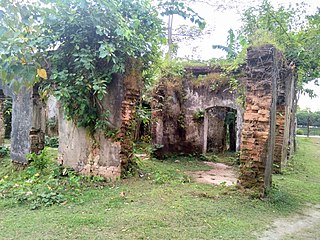Related Research Articles

Sir Jadunath Sarkar, was a prominent Indian historian and a specialist on the Mughal dynasty.

The Pashchimbanga Bangla Akademi is the official regulatory body of the Bengali language in India. It was founded on 20 May 1986 in Kolkata to act as the official authority of the language and is entrusted with the responsibility of reforming Bengali spelling and grammar, compiling dictionaries, encyclopedias and terminologies and promoting Bengali language and culture in West Bengal. They are widely accepted by the Governments of West Bengal and Tripura as well as a considerable number of private publishing houses and institutions such as the Oxford University Press and the Ramakrishna Mission.

Sheikh Fazlul Karim, also known by his daak naam Mona, was a Bengali poet and writer. He was born in Lalmonirhat.

Phulbari is an upazila of Kurigram District in the Division of Rangpur, Bangladesh.

Rajarhat is an upazila of Kurigram District in the Division of Rangpur, Bangladesh. Since 1981 it has been a Thana and later on September 14, 1983, it was turned into an upazila by the government.

Aditmari is the smallest upazila (sub-district) of Lalmonirhat District in Rangpur Division, Bangladesh.

Kaliganj is an upazila of the Lalmonirhat District in Rangpur Division, Bangladesh.

Patgram is an upazila of Lalmonirhat District in Rangpur Division, Bangladesh. It had 27 enclaves, most notably Dahagram–Angarpota which is connected to the Bangladeshi mainland through the Tin Bigha Corridor.

Gangachara is the northernmost upazila of Bangladesh's Rangpur District, located in the Rangpur Division.

Romesh Chunder Dutt was an Indian civil servant, economic historian, translator of Ramayana and Mahabharata. He was one of the prominent proponents of Indian economic nationalism.

Sarat Kumar Ray (1876–1946) was a member of the royal family of Dighapatia. A noted scholar, he was the son of the Raja (King) Pramathanath Ray and lived in the Maharaja's Palace. Along with historian Ramaprasad Chanda, he co-founded the Varendra Research Museum, which Lord Dundas the Governor of Bengal, inaugurated in November 1919. He was well traveled, and visited England in 1900. He was a friend of Rabindranath Tagore.

The Kamarupa Anusandhana Samiti is the oldest Research institution in North-East India, which was established in the year 1912 at Kamakhya with a view to working in the field of antiquarian study and research, particularly on the subject of History, Archaeology, Anthropology, Culture etc. It was this society that started the Museum movement for the collection and preservation of antiquities culminating in the birth of the Assam State Museum in 1940.

Nagendranath Basu was an archaeologist, encyclopaedist, Kayastha activist and a nationalist social historian of Bengal.

Mankar is a village in Galsi I CD Block in Bardhaman Sadar North subdivision of Purba Bardhaman district in the state of West Bengal, India.
Maharaja Jagadindra Nath Roy Bahadur (Moitra) (20 October 1868- 5 January 1925) known as the Maharaja of Natore was a noted zamindar of Natore from Bengal and 2nd last King of Undivided Bengal. He is also noted for his contribution to the game of cricket in British India.
Sajanikanta Das was a Bengali poet, literary critic and editor of Shanibarer Chithi.

Kurigram-3 is a constituency represented in the Jatiya Sangsad of Bangladesh. Since 6 August 2024 The constituency is vacant.
Rangapur Sahitya Parisad was a Bengali literary society founded in the early 20th century.

The zamindars of Mahipur were a Bengali aristocratic family of feudal landowners. The zamindari estate encompassed the Chakla of Qazirhat under the Cooch Behar State since the Mughal period. Although their aristocratic status was lost with the East Bengal State Acquisition and Tenancy Act of 1950, the Mahipur estate remains an important part of the history of Rangpur and belongs to one of the eighteen ancient zamindar families of Rangpur. The zamindari palace was lost as a result of flooding from the Teesta River, although the mosque, cemetery, polished reservoir and large draw-well can still be seen today.
Karim Uddin Ahmed was a Bangladesh Awami League politician and a Jatiya Sangsad member representing the Rangpur-6 constituency during 1973–1979.
References
- ↑ "Lalmonirhat District". www.lalmonirhat.gov.bd. Archived from the original on 2021-07-11. Retrieved 2021-07-11.
- 1 2 3 "Rangpur Sahitya Parishad - Banglapedia". bn.banglapedia.org. Retrieved 2021-07-11.
- ↑ "Anniversary Issue". Jugantor. Retrieved 2021-07-11.
- 1 2 Council, Editor (2000). History of Rangpur District. Rangpur: Rangpur District Council. p. 579.
{{cite book}}:|first=has generic name (help) - ↑ "On the Path of Destruction: The Lighthouse of Literary Practice in Rangpur". mithapukur24news.com. 2019-12-06. Retrieved 2021-07-11.
- ↑ "Protests Against the Decision to Demolish a 150-Year-Old Structure in Rangpur". banglanews24.com (in Bengali). Retrieved 2021-07-11.
- ↑ "Dilapidated Building, No Repairs". Dainik Shiksha. Retrieved 2021-07-11.
- ↑ "Rangpur Palio and Nakara Reports". mugdhota.com. Retrieved 2021-07-11.